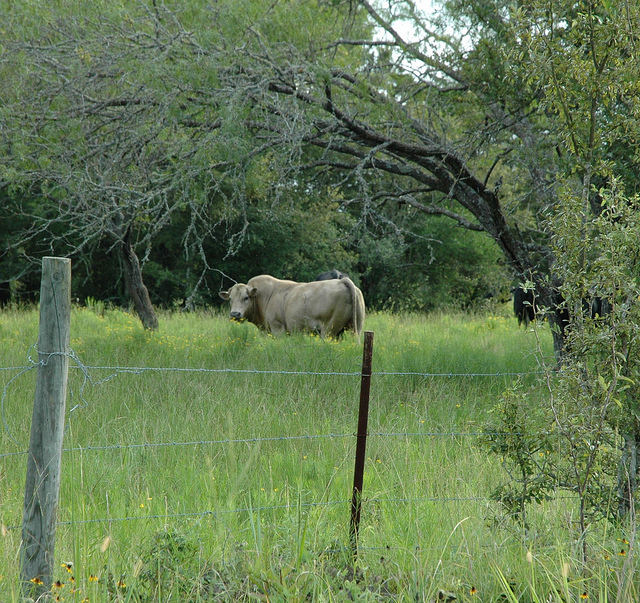*UPDATE In January 2020, the Texas Supreme Court reversed. To read a blog post on that Opinion, click here.

This week, we are continuing this blog series with the second recent fence law case released by a Texas court. If you missed Part I discussing Dearbonne v. Courville, click here.
Today, we will focus on an opinion from the San Antonio Court of Appeals in Garcia v. Pruski, a case involving a motorist colliding with a bull on the highway. [Read full Opinion here.]

TAMU AgriLife photo by Kathleen Phillips
Background
Plaintiff, Mr. Garcia, was injured when his vehicle struck a bull on State Highway 123 in Wilson County. Mr. Pruski (“Defendant”) owned property abutting the road that was enclosed by a six-strand barbed wire fence. He also owned the bull that escaped, wandered onto the highway, and was hit by Plaintiff. The bull was killed in the accident that occurred near a gate into Defendant’s pasture, which was open at the time the accident occurred. Defendant testified that the bull broke the latch on the gate. Defendant had a lock on the gate, but it was not locked at the time the bull escaped as he left unlocked to allow a contractor to enter the property. Defendant testified the only other time cattle escaped from the property was one time 8 years ago when a cow was struck by a vehicle on the same highway.
Legal Arguments
Plaintiff sued Defendant claiming that he was negligent in permitting the bull to run at large. Specifically, Plaintiff claims that Defendant failed to property restrain and restrict bull to the fenced in area on Defendant’s property, failed to prevent the bull from gaining access to the highway, and for violating Chapter 143 of the Texas Agriculture Law Code.
The trial court granted the Defendant’s Motion for Summary Judgment and dismissed the case. The Plaintiffs appealed.
Opinion
The San Antonio Court of Appeals begins by explaining that in cases involving animals struck by motorists, there is no common law duty for landowners to control or restrict the movement of their livestock. The only way such duty arises, then, is by statute. Plaintiff argued that Defendant owed a duty under Sections 143.071 and 143.102 of the Texas Agriculture Code. Defendant argued that he owed a duty only under Section 143.102.
Section 143.102
The Texas Agriculture Code Section 143.102 provides “A person who owns or has responsibility for the control of a horse, mule, donkey, cow, bull, steer, hog, sheep, or goat may not knowingly permit the animal to traverse or roam at large, unattended, on the right-of-way of a highway.” The parties agree that this duty applies to Defendant. They disagree, however, about whether Defendant “knowingly permitted” the bull to roam at large on State Highway 123.
The Texas Agriculture Code does not define “knowingly permit.” Black’s Law Dictionary defines “knowing” as “having or showing awareness or understanding” or “deliberate conscious.” This standard is not met, the court held, if the person merely “should have known.”
Analyzing the facts here, the court found that the Plaintiff did not offer sufficient evidence that Defendant knowingly permitted the bull to run at large. Despite having cattle escape once before and failing to lock the gate, the court found that Defendant was not aware his bull would break the latch and enter the highway. Thus, the Court agreed with the trial court finding of no violation of Section 143.102.
Section 143.071
This section of the Texas Agriculture Code allows local counties to hold elections to pass local stock laws, imposing a duty on livestock owners to fence their animals in. Specifically, if a county has passed a local stock law pursuant to this section, the law provides that “a person may not permit any animal of the class mentioned in the proclamation to run at large in the county or area in which the election was held.” See Texas Agric. Code Section 143.074. This type of stock law was passed for Wilson County in 2010 and prohibits landowners from permitting cattle to run at large.
Plaintiff argues that this duty not to “permit” a bull to run at large applies to Defendant.
Defendant argues it does not, due to a conflict between the duty owed in Section 143.102 and 143.071. Specifically, Defendant argues that because Section 143.102 states that an owner may not “knowingly permit” livestock to run at large, while Section 143.071 provides that an owner may not “permit” livestock to run at large, these differing standards result in a conflict. That conflict, Defendant argues, is resolved in favor of Section 143.102 based on the Code’s language providing that Section 102 shall prevail over any conflict with remaining portions of the Code. See Texas Agric. Code Section 143.107.
The court held that the two sections did not conflict. No part of Section 143.071 allows individuals to knowingly permit animals to roam at large on a highway, which is prohibited by Section 143.071. Thus, the court reasons, there is no conflict despite the differing legal duties–knowingly permit versus permit–in the statues. The court explains that these two provisions work in conjunction with each other and a person could violate both a local stock law passed under 143.071 as well as the highway exception under 143.102. The court says it would lead to “absurd results” if it were to apply the “permit” standard to an entire county except for state and federal highways, where the “knowingly permit” standard would be applied.
Thus, Defendant also owed a duty under Section 143.071 not to “permit” his animals to run at large.
This statute does not define what is meant by “permit.” The court stated that a breach of a local stock law may be proven “by evidence showing the person was at fault in allowing any mentioned animal to run at large.” The court relied on the following evidence to find that Plaintiff raised a genuine issue of fact as to whether Defendant “permitted” the bull to run at large: (1) Defendant did not lock the gate; (2) Defendant knew there was a significant risk of the bull breaking the latch if he did not lock it; and (3) Defendant did not have a cattle guard.
Thus, the court held that the trial court erred in dismissing this claim of breach under the local stock law and reversed and remanded the case back to the trial court on this issue.
Take Away Points
This case raises an interesting discussion of the meaning and result of the different standards in Texas fence law when duties to fence animals in are imposed on landowners. The different standards between the highway exception’s “knowingly permit” and the local stock law’s “permit” create a question of which should apply in the event an animal is struck in an area where both exist–namely, on a highway in a county with a stock law. Given the language in the statutes that the highway exception prevails over any conflict, it is interesting that the Court determined that the bull owner owed duties under both standards in this case.
Further, livestock owners should consider the slight evidence of negligence offered here–latching but not locking a gate and not having a cattle guard–was sufficient for this court to allow the case to proceed to jury trial on the question of whether these facts sufficiently proved that the bull owner “permitted” the animal to run at large. This may be of some concern to Texas livestock owners and demonstrates that there is no substitute for good practices such as continued inspections and vigilance on maintaining good fences.
For more info on fence law, check out Five Strands: A Landowner’s Guide to Fence Law in Texas.











